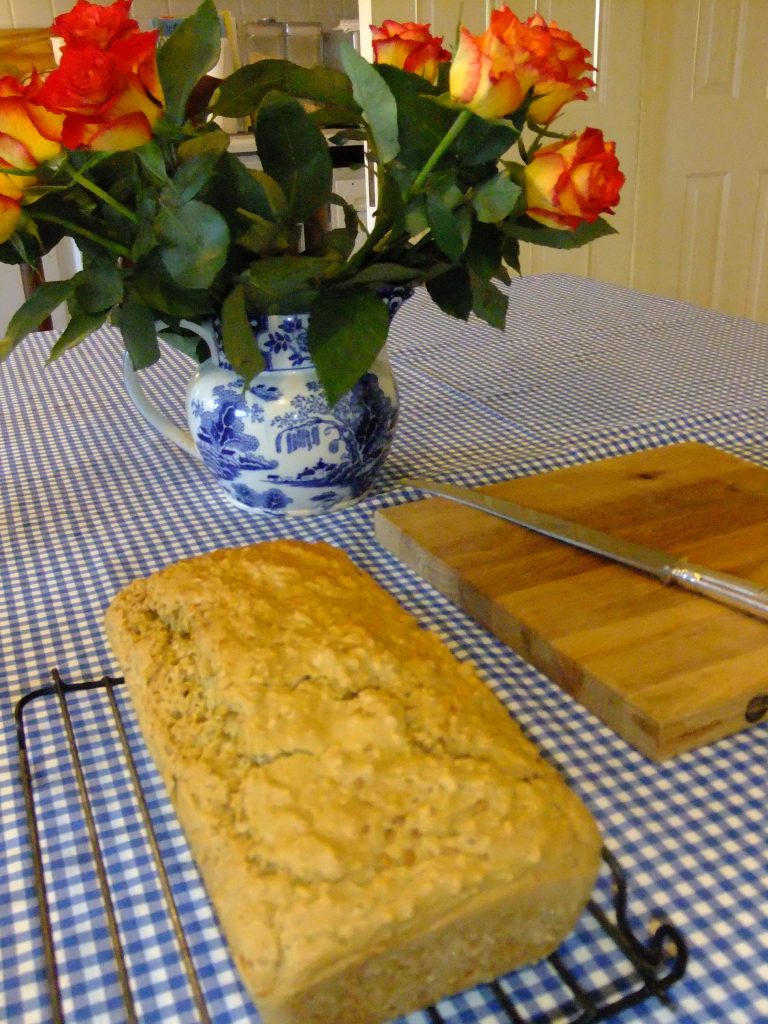Since developing this recipe I’ve developed a simpler, yeast version that I find even more delicious (see super simple quinoa and rice yeast bread on this blog). But I’m leaving this recipe here in case you’re avoiding yeast. I developed this recipe as an alternative to the delicious (but horribly expensive) gluten-free quinoa bread by Artisan Bakery Originals. This is a lovely soft bread with a soft golden brown crust. It rises as well as any wheaten soda bread but has the gorgeous flavour of quinoa. You could use the mixture for scones too, spooning it into well-oiled muffin tins instead of a loaf tin and ajusting the cooking time. Slice up and freeze whatever you don’t eat within a day or two. Remember (if you are gluten-intolerant or coeliac) to use a separate toaster or grill from gluten-eaters for your bread to avoid being contaminated.
For one small (450g) loaf
325 ml generous 1½ cups unsweetened almond milk/coconut milk or (if you eat dairy) kefir or buttermilk
25g whole linseeds* (flax seeds), soaked for 2-3 hours/overnight in the milk above
75g potato flour
150g quinoa flour
75g quinoa flakes
1 rounded teaspoon xanthan gum
25g rice bran (or if you are OK with gluten you can use oat bran)
½ level tsp natural sea salt (eg. Atlantic/Maldon/Himalayan – other salts contain harmful additives)
1 rounded teaspoon aluminium–free bread soda
1 large egg, beaten
3 tbs extra virgin olive oil or macadamia oil
Tinfoil
1 small loaf tin (about 1250ml or 2 pint capacity)
1. Remember to soak the whole linseeds for 2-3 hours or overnight in the milk. This is crucial, otherwise the bread will not bind together and will fall apart.
2. Preheat oven to 190C or fan 175C
3. Grease and bottom-line a loaf tin with baking parchment/silicon paper
4. Sieve the flours, xanthan gum, salt and bread soda into a bowl, add the other dry ingredients and mix well.
5. Pour off a cupful of the buttermilk and reserve. Add the rest of the buttermilk with the flax (linseeds), oil and beaten egg to the dry ingredients.
6. Add enough of the reserved cupful of buttermilk to make a thick batter (sometimes the mix may take more liquid than at other times depending on the absorbency of the dry ingredients). The mixture should be soft enough to pour into the tin (a bit wetter than queen cake mixture).
7. Bake for about 1 hour. Test after 50 mins with a metal skewer to ensure that it is done in the middle (the skewer will come out clean if it is done). The bread will also shrink away a little from the sides of the tin when its done, like in this picture.
8. If the bread is getting too brown during baking, cover with a sheet tin foil.
9. Turn onto a wire tray to cool.
* although nut and seed oils are damaged by baking, whole linseeds seeds are too small for the body to break down and therefore they pass through the digestive system undigested. Therefore their (heat-damaged oils) are unlikely to be harmful because you cant digest them! The soluble fibre in the linseeds still does you good by providing food for your body’s beneficial bacteria. The fibre comes out of the intact seeds as a gel when you soak the seeds.
Why this bread is good for you:
Quinoa is packed with nutrients such as B vitamins and chromium. It’s also high in protein at 14g per 100g of the raw grain. This means quinoa is a great choice for a bread to help keep your blood sugar (and energy levels) even. Quinoa is easier on your digestive system than wheat. This is because wheat binds (inactivates) the beneficial, healing substance N-acetyl glucosamine (NAG) in our gut. So if you eat a lot of wheat, even wholewheat, for many decades you are more likely to have digestive issues e.g. gastritis, malabsorption, food intolerances, gastritis or bowel issues. Wheat also binds zinc and other minerals in your digestive system, making them hard to absorb. If you can afford to, buying the organic ingredients also makes sense as you are avoiding chemical residues. Wheat is sprayed with pesticides around 16 times (!!) between sowing and harvesting. Sadly, wholewheat, which contains nutrients, is the most likely to be contaminated of all the grains we commonly eat. Switching to a lower-grain diet, and using other (whole)grains, like quinoa, can make a great contribution to your health. High carb foods like grains (even quinoa) or potatoes should make up no more than a quarter of our adult diets if we want health and vitality.


